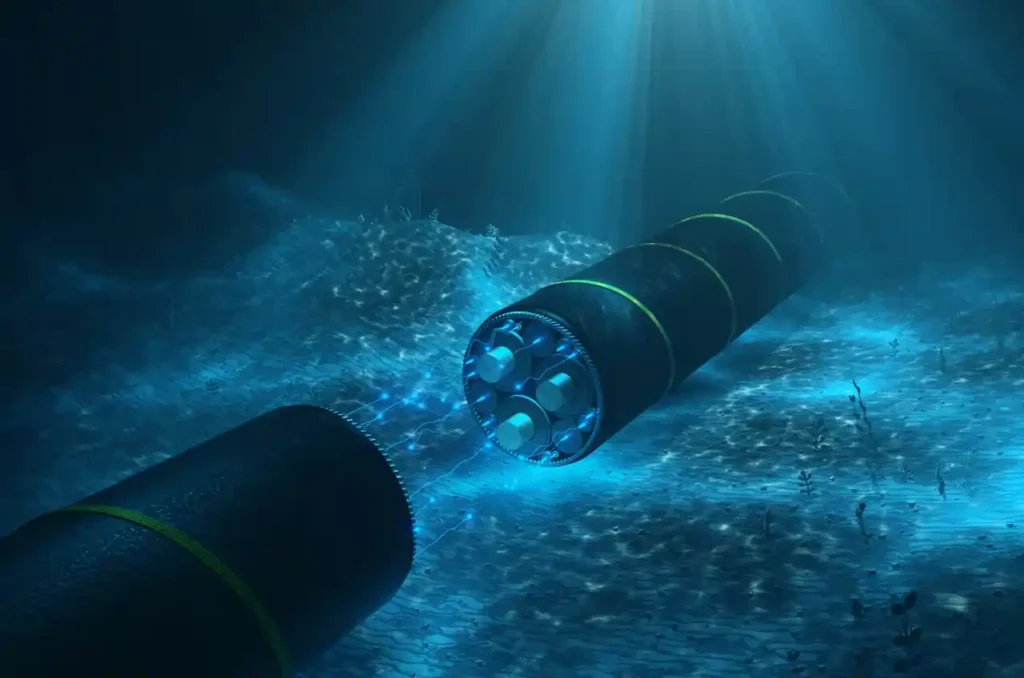New Delhi: A series of undersea cable cuts in the Red Sea has triggered widespread internet outages across parts of Asia and the Middle East, including India, exposing vulnerabilities in global digital infrastructure and spotlighting India’s Underwater Domain Awareness (UDA) efforts. Reported on September 8, 2025, the disruptions have affected millions of users, slowed internet speeds, and raised concerns about the security of critical submarine cables amid escalating geopolitical tensions in the region.

Details of the Red Sea Cable Disruptions
The outages stem from damage to multiple submarine cables in the Red Sea, a critical hub for global internet traffic. Microsoft reported via its status website that the Middle East “may experience increased latency due to undersea fiber cuts in the Red Sea.” The company noted that internet traffic not routed through the Middle East was unaffected but provided no further details on the cause of the cuts.
According to NetBlocks, a cybersecurity organization monitoring internet access, the outages impacted the South East Asia–Middle East–Western Europe 4 (SMW4) and India-Middle East-Western Europe (IMEWE) cable systems near Jeddah, Saudi Arabia. The SMW4 cable, operated by Tata Communications, spans 18,800 kilometers, connecting Marseille (France) and Palermo (Italy) to countries across Asia and North Africa, including Singapore, Malaysia, Thailand, Bangladesh, India, Sri Lanka, Pakistan, United Arab Emirates, Saudi Arabia, Egypt, Tunisia, and Algeria. Built in 2005 at a cost of $500 million (€426.40 million), it is a joint venture between France’s Alcatel Submarine Networks (ASN) and Japan’s Fujitsu.
The IMEWE cable, managed by a consortium led by Alcatel Submarine Networks, is a $480 million (€409.35 million) project covering 12,091 kilometers, linking France and Italy to India through the Middle East. Additionally, Kuwaiti authorities reported that the FALCON GCX cable, also running through the Red Sea, was severed, disrupting connectivity in the oil-rich nation. Neither Tata Communications, Alcatel Submarine Networks, nor GCX responded to requests for comment.
In Pakistan, the Pakistan Telecommunications Co. Ltd. confirmed the cuts in a statement on September 7, 2025. In the United Arab Emirates, users on state-owned networks like Du and Etisalat reported slower internet speeds, though the government did not officially acknowledge the issue. Saudi Arabia, where multiple cables were cut, also remained silent, with authorities not responding to inquiries.
The cause of the cuts remains unclear. Undersea cables, which form the backbone of the internet alongside satellite and land-based connections, are vulnerable to both accidental damage—often from ship anchors or fishing activities—and deliberate attacks. The International Cable Protection Committee estimates that the world’s 1.7 million kilometers of undersea cables face 150–200 incidents annually, with up to 80% caused by human activities and the rest by natural hazards. Repairs can take weeks, requiring specialized ships to locate and fix damaged sections.
Geopolitical Tensions and Houthi Involvement
The timing of the cable cuts has fueled speculation about intentional sabotage, particularly given the ongoing Red Sea campaign by Yemen’s Houthi rebels. The Iranian-backed group describes its actions as an effort to pressure Israel to end its war on Hamas in the Gaza Strip. Between November 2023 and December 2024, the Houthis attacked over 100 ships with missiles and drones, sinking four vessels and killing at least eight mariners. In July 2025, they sank two additional ships, resulting in at least four more deaths, with others believed to be held captive.
Concerns about cable targeting intensified after Yemen’s internationally recognized government in exile alleged in early 2024 that the Houthis planned attacks on Red Sea cables. While several cables were damaged that year, possibly by a Houthi-attacked ship dragging its anchor, the rebels denied responsibility. On September 8, 2025, the Houthi-run al-Masirah satellite news channel acknowledged the recent cuts, citing NetBlocks, but again disclaimed involvement.
Moammar al-Eryani, the information minister for Yemen’s anti-Houthi government based in southern Yemen, stated that the cuts “cannot be isolated from the series of direct attacks carried out by the Houthi militia.” He called for a firm international response to protect digital infrastructure, describing it as “the lifeline of the modern world.” The Houthis briefly paused attacks during a ceasefire, but resumed amid a U.S.-led airstrike campaign ordered by President Donald Trump, which ended with a declared ceasefire. The incident coincides with delicate negotiations for a potential new ceasefire in the Israel-Hamas war and uncertainty surrounding U.S.-Iran talks on Tehran’s nuclear program, following Israel’s 12-day war against Iran, during which U.S. forces bombed three Iranian atomic sites.
The Critical Role of Undersea Cables
Undersea cables are a cornerstone of global internet infrastructure, carrying over 95% of international data traffic through fiber-optic cables that transmit data as pulses of light using total internal reflection. The Red Sea is a vital chokepoint, with over 90% of Europe-Asia internet capacity routed through its cables, according to TeleGeography. Internet service providers typically maintain multiple access points to reroute traffic during failures, but such rerouting often results in slower connectivity, as seen in this incident.
Who Manages Undersea Cables?
The laying and maintenance of undersea cables are handled by private companies and international consortiums, not governments. In India, which relies on these cables for over 95% of its international data, 17 international cables land at 14 stations in Mumbai, Chennai, Cochin, Tuticorin, and Trivandrum. Key players include:
- Tata Communications: Operates five landing stations—three in Mumbai, one in Chennai, and one in Cochin.
- Global Cloud Xchange: Manages the Versova station in Mumbai for the FALCON cable and the Trivandrum station for the WARF cable, connecting the Maldives and Sri Lanka to India.
- Reliance Jio: Runs the BBG station in Chennai and the AAE-1 station in Versova, Mumbai, and is developing stations for its India-Asia-Express (IAX) and India-Europe-Express (IEX) cables.
- Bharti Airtel: Controls three stations—two in Chennai and one in Mumbai—and will serve as the landing party for the 2Africa/EMIC-1 and SEA-ME-WE 6 cables.
- Sify Technologies: Operates the Mumbai station for the MENA and GBI systems.
- BSNL: Owns the Tuticorin station for the BLCS cable to Sri Lanka, has completed the Chennai-Andaman & Nicobar Islands system, and is expected to own the new Digha station in West Bengal.
- Vodafone: Manages the BBG station in Mumbai.
- Lightstorm: Acts as the landing partner for Cinturion’s TEAS cable and is building a carrier-neutral Cable Landing Station.
- IOX: Plans a new station in Puducherry for its IOX cable.
Globally, companies like SubCom, Alcatel Submarine Networks, and TE SubCom deploy these cables using specialized ships that avoid deep-sea hazards and sensitive areas.
India’s Expanding Undersea Network
To enhance connectivity and reduce outage risks, India is expanding its undersea cable network. Projects like the India-Asia-Express (IAX), India-Europe-Express (IEX), and 2Africa Pearls will boost international bandwidth. Meta’s Project Waterworth, the world’s longest undersea cable system, will connect India to the US, South Africa, Brazil, and other regions. These initiatives are crucial for supporting India’s digital economy, powering technologies like AI, cloud computing, and 5G, and ensuring resilience against future disruptions.
India’s Underwater Domain Awareness (UDA) in Focus
The Red Sea incident has underscored the importance of India’s Underwater Domain Awareness (UDA), defined as the ability to monitor, detect, and assess activities beneath the surface of oceans and seas.
Why UDA Matters for India
- National Security and Regional Stability: China’s Underwater Great Wall project and other regional threats necessitate robust surveillance to counter potential incursions.
- Protecting Critical Infrastructure: Submarine cables, vital for global data transmission, require safeguarding to maintain connectivity.
Challenges to India’s UDA
- Technological Gaps: India’s development of Unmanned Underwater Vehicles (UUVs) is in its early stages. The DRDO’s phosphoric acid fuel cell-based Air Independent Propulsion (AIP) system for submarines is less advanced than lithium-ion alternatives. Bharat Electronics Limited’s Unmanned Surface Vehicle (USV) for bathymetric surveys has a limited 30-kilogram payload, leading to import dependency for critical equipment.
- Financial Constraints: Lack of sustained funding for startups hinders prototype development.
- Operational Difficulties: India’s vast coastline, Chinese submarine incursions, seasonal monsoons, and fragmented inter-agency coordination pose significant challenges.
India’s UDA Initiatives
- Indigenous Development: India is advancing UUVs like MAYA, AMOGH, and ADAMYA to enhance naval surveillance. The Matsya 6000 manned submersible, part of the Samudrayaan project, is under development.
- Infrastructure: The Integrated Underwater Harbour Defence and Surveillance System (IUHDSS) has been deployed in Port Blair.
- International Partnerships: Collaboration with the US focuses on co-developing autonomous undersea technologies and equipping MQ-9B Sea Guardian drones with sonobuoys.
Looking Ahead
The Red Sea cable cuts highlight the fragility of global digital infrastructure and the strategic importance of undersea cables. As investigations continue into the cause—amid Houthi denials and accusations from Yemen’s government—India must prioritize strengthening its UDA and diversifying cable routes to ensure uninterrupted connectivity. With its expanding undersea network and proactive initiatives, India is poised to enhance its digital resilience, but sustained investment and international cooperation will be key to addressing future challenges.
Frequently Asked Questions
1. What caused the internet disruptions in India, the Middle East, and Asia on September 8, 2025?
The internet outages were triggered by cuts to multiple undersea cables in the Red Sea, including the South East Asia–Middle East–Western Europe 4 (SMW4), India-Middle East-Western Europe (IMEWE), and FALCON GCX cables. The exact cause remains unclear, with possible reasons ranging from accidental damage by ship anchors or fishing activities to deliberate attacks. The International Cable Protection Committee notes that 150–200 such incidents occur annually, with up to 80% caused by human activities and the rest by natural hazards. Amid regional tensions, Yemen’s Houthi rebels have been accused of targeting cables, though they deny involvement.
2. Why are undersea cables so critical to global internet connectivity?
Undersea cables carry over 95% of global internet traffic, transmitting data as pulses of light through fiber-optic cables using total internal reflection. They form the backbone of the internet, alongside satellite and land-based connections. The Red Sea is a key hub, with over 90% of Europe-Asia internet capacity routed through its cables, according to TeleGeography. When these cables are damaged, internet service providers can reroute traffic, but this often leads to slower speeds and increased latency, as seen in the recent outages affecting India, Pakistan, and the Middle East.
3. Who is responsible for laying and maintaining undersea cables in India?
Private companies and international consortiums, not governments, handle the laying and maintenance of undersea cables. In India, 17 international cables land at 14 stations in cities like Mumbai, Chennai, Cochin, Tuticorin, and Trivandrum. Key players include Tata Communications (operating five stations), Reliance Jio, Bharti Airtel, Sify Technologies, BSNL, Vodafone, Lightstorm, and IOX. Globally, companies like SubCom and Alcatel Submarine Networks deploy cables using specialized ships. India is expanding its network with projects like the India-Asia-Express (IAX), India-Europe-Express (IEX), and Meta’s Project Waterworth.
4. What is India’s Underwater Domain Awareness (UDA), and why is it important?
Underwater Domain Awareness (UDA) refers to a nation’s ability to monitor, detect, and assess activities beneath the surface of water bodies like oceans and seas. For India, UDA is critical for national security, countering threats like Chinese submarine incursions and projects like China’s Underwater Great Wall, and protecting critical infrastructure such as submarine cables. Challenges include technological gaps (e.g., early-stage Unmanned Underwater Vehicles), financial constraints, and operational difficulties due to India’s vast coastline and monsoons. Initiatives like the Samudrayaan project’s Matsya 6000 submersible and U.S. partnerships for autonomous technologies aim to bolster UDA.
5. How is India responding to the vulnerabilities exposed by the Red Sea cable cuts?
India is addressing these vulnerabilities through multiple strategies. It is developing indigenous technologies like Unmanned Underwater Vehicles (MAY, AMOGH, ADAMYA) and the Matsya 6000 submersible. Infrastructure enhancements include the Integrated Underwater Harbour Defence and Surveillance System (IUHDSS) in Port Blair. India is also expanding its undersea cable network with projects like IAX, IEX, and 2Africa Pearls to improve connectivity and resilience. International cooperation, particularly with the U.S. for autonomous undersea technologies and equipping MQ-9B Sea Guardian drones with sonobuoys, further strengthens India’s capabilities to safeguard its digital and maritime infrastructure.

